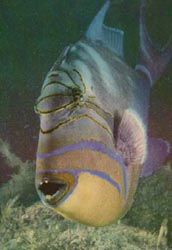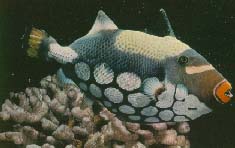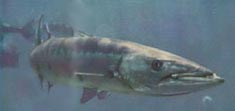| Triggerfishes
Triggerfishes are named because of the two fin spines
on their dorsal (top) fins. When the fish becomes frightened,
it dives into a coral head and the fish's long dorsal spine
goes up. A very small second spine moves forward to lock
the first spine into its upright position. The tall spine
can not be pushed down until the small trigger spine is
released. This makes it impossible for predators (or humans
who are fish collectors) to get to the triggerfish without
breaking down the coral. Triggerfishes are slow-moving carnivorous
(meat-eating) fish who live in shallow water. They have
eight outer teeth in each jaw and six plate-like inner teeth
in their upper jaw. Some of them have beautiful markings,
and they usually do not get any bigger than 2 feet in length.
Barracudas
Barracudas are carniverous (meat-eating) torpedo-shaped
fish that vary in size from 18 inches to about 6 feet long.
They can be recognizes by their lower jaw, which juts out
past the upper part of their mouth, and their fanglike teeth.
Some divers fear them more than sharks because they are
more curious about people than sharks and have been known
to follow people. Unlike a shark, a barracuda makes a single
attack and leaves a wound with no jagged edges. The great
barracuda is a species that is very dangerous in the West
Indies but has not been known to attack people in the Hawaiian
region. Various species of barracuda live in different parts
of the world, including the Atlantic and Pacific Oceans
and the Mediterranean Sea.
|

Queen Triggerfish
photo by Friz Goro,
Living Fishes of the World, p. 259

Spotted Triggerfish
photo by Hans and Klaus Paysan
Living Fishes of the World, p. 258

Great Barracuda
photo by Friz Goro,
Living Fishes of the World, pp. 216-17
|




